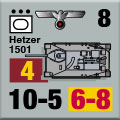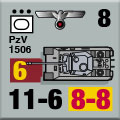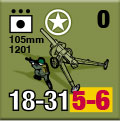| Dragon’s Teeth:
Scenario Preview, Part Four
By Mike Bennighof, Ph.D.
April 2024
 There’s probably a limit to the number of battles that took place during World War II and are suitable to depict as Panzer Grenadier scenarios. But that number is astronomically large: there were a lot of battles between forces with a couple of battalions on each side, lasting less than a day (and if they lasted more than a day, those can be broken into a two or more scenarios). There’s probably a limit to the number of battles that took place during World War II and are suitable to depict as Panzer Grenadier scenarios. But that number is astronomically large: there were a lot of battles between forces with a couple of battalions on each side, lasting less than a day (and if they lasted more than a day, those can be broken into a two or more scenarios).
Some situations have more potential than others, but there aren’t many as perfectly suited to a Panzer Grenadier treatment as the Siegfried Line of late 1944, the subject of Panzer Grenadier: Dragon’s Teeth. There’s the U.S. Army, well-armed and now thoroughly blooded in the advance across France and Belgium. Against them, the remnants of the German Army in the West, shattered and bled white by the Allied juggernaut, they finally have a breathing space thanks to the West Wall fortifications and can restore their strength. It’s not an even distribution: Some of the German units are very good, filled with combat veterans armed with the best that Germany can produce; some of the American units are either brand-new to combat, or badly in need of replacements.
That yields scenarios pitting solid formations against weak ones, solid formations against opposing formations that are just as solid, or weak ones against weak ones. You get a wide mix of battles: tank battles, infantry assaults, and small, intense fights by mixed combat groups. Each opposing force gets to attack and defend as the Americans grind forward and the German fight fanatically to push them back off German soil.
This campaign is perfect for Panzer Grenadier. So let’s have a look at the fourth chapter:
Chapter Four
Miracle of the West
In September 1944, the German Army was a beaten, shattered force. By November, standing on German soil and calling up additional manpower, the line had been strengthened with dozens of new or rebuilt divisions while still more and machines formed a growing reserve earmarked for a counter-offensive. This “Miracle of the West,” as German propaganda named it, would see the American advance stopped and even thrown back off German soil.
On the American side, a renewed offensive awaited reduction of the pocket around Aachen, where formal resistance ended on 21 October. That cleared the way for the next offensive from the border zone across the Roer River to the banks of the Rhine, what VII Corps commander “Lightning Joe” Collins called “a giant step.”

Spearhead Division soldiers take a well-earned break from killing Nazis.
The giant step would require reinforcements. The new Ninth Army headquarters took command of what had been the northern wing of First Army, the XIX Corps, to which is would eventually add the new XIII Corps. Each of the divisions involved in the fighting for the West Wall and Aachen again required thousands of replacements. And a new offensive meant, under American doctrine, massive amounts of artillery ammunition to pave the way.
Two of the three corps remaining to First Army received an additional, newly-arrived infantry division, and all three corps added additional non-divisional units (anti-aircraft, tank, tank destroyer, engineer and especially artillery battalions). Despite the detachment of XIX Corps to Ninth Army, First Army’s ration strength rose from the 256,000 men who had confronted the Siegfried Line in mid-September to 318,000.
While the Germans were well aware of the scope of the American power surge, if not its particulars, the extent of the German military revival would surprise and even shock American commanders. The giant step to the Roer River would not be an easy one.
Scenario Twenty-Three
Return to the Donnerberg
16 November 1944
 Bad weather delayed the American offensive for almost a week until the skies finally cleared around noon on the 16th. The Allies immediately called in the largest close air support mission of the war, and American troops followed in the bombers’ wake. The newly-arrived 414th Infantry Regiment had the toughest job of the day: recapturing an objective the Americans had won and then lost just two months before: Hill 287, known as the Donnerberg. Bad weather delayed the American offensive for almost a week until the skies finally cleared around noon on the 16th. The Allies immediately called in the largest close air support mission of the war, and American troops followed in the bombers’ wake. The newly-arrived 414th Infantry Regiment had the toughest job of the day: recapturing an objective the Americans had won and then lost just two months before: Hill 287, known as the Donnerberg.
Conclusion
Though 104th Infantry Division had been involved in some skirmishing while under British command, this was their first major action. With their supporting armor also un-blooded, it was no surprise that things didn’t go well. First Battalion managed to gain all of 400 yards before calling it quits, and 3rd Battalion was thrown back every time it managed to edge forward. Second Battalion bypassed the Donnerberg to the right and continued on almost 1,000 yards before being stopped. Eschweiler remained a distant dream.
Notes
The Timberwolves of the 104th Infantry Division would become a very good, battle-hardened outfit by the end of the war. This is not that version of the Timberwolves. They’re green and weakly led, even if they do get a goodly ration of artillery support.
Scenario Twenty-Four
The Storming of Gressenich
16 November 1944
 VII Corps ordered the 9th Infantry Division’s 47th Infantry Regiment, temporarily attached to the 1st Infantry Division, to secure the town of Gressenich. The veteran regiment’s men welcomed the opportunity to leave the rain-filled (or more recently snow-filled) foxholes in which they had lived for two months. After the bombers left, the Big Red One moved forward. VII Corps ordered the 9th Infantry Division’s 47th Infantry Regiment, temporarily attached to the 1st Infantry Division, to secure the town of Gressenich. The veteran regiment’s men welcomed the opportunity to leave the rain-filled (or more recently snow-filled) foxholes in which they had lived for two months. After the bombers left, the Big Red One moved forward.
Conclusion
Five battalions of artillery pounded Gressenich to subdue the defenders while plentiful armor support aided the reinforced Big Red One. Even this might not have been enough if Task Force Lovelady’s advance on Mausbach had not distracted the defenders. This allowed the Americans to enter the town where they had to overcome “good troops, better than most (we) had met” according to Lt. Col. James Allgood.
Notes
The Americans seemingly have all the advantages, until you look at the map and the special rules. The weather sucks, which is makes everything slow, and the Americans have to advance up a long, narrow battlefield to reach their objectives. This one won’t be easy for anyone.
Scenario Twenty-Five
Repulse at Wurselen
16 November 1944
 The North Carolina National Guard’s 119th Infantry Regiment was under-strength because one of its battalions had been detached to provide infantry support for the 2nd Armored Division. With the other two regiments of 30th Infantry Division at full strength and well-rested, it was surprising when the 119th was given the job of securing Wurselen. The North Carolina National Guard’s 119th Infantry Regiment was under-strength because one of its battalions had been detached to provide infantry support for the 2nd Armored Division. With the other two regiments of 30th Infantry Division at full strength and well-rested, it was surprising when the 119th was given the job of securing Wurselen.
Conclusion
The plans called for the entire 3rd Battalion of the 119th to attack, with Company L detailed to secure Wurselen. They would receive the support of an entire company of Shermans once they cleared the first crossroads in town. But despite starting less than 1,000 yards away they never reached the crossroads. Company L was stymied in every attempt to move forward, while absorbing numerous casualties. Things didn’t go much better for Companies I and K, which inched forward but were unable to seriously threaten the town. Thankfully, they suffered far fewer casualties.
Notes
A small American attacking force is taking on an even smaller band of German defenders, on another narrow battlefield with equally crappy weather. I love these small-scale, fearsome infantry fights; they’re hard to design well but fun to play.
Scenario Twenty-Six
The Road to Puffendorf
16 November 1944
 Second Armored Division’s initial objective was to sever the Germans’ last north-south line of communication west of the Roer River. Only a small strip of groundd leading to Puffendorf was suitable for armored vehicles, and the constant rains had turned it muddy. After taking a tank ride to test the off-road conditions, division commander Maj. Gen. Ernest N. Harmon ordered the advance. Second Armored Division’s initial objective was to sever the Germans’ last north-south line of communication west of the Roer River. Only a small strip of groundd leading to Puffendorf was suitable for armored vehicles, and the constant rains had turned it muddy. After taking a tank ride to test the off-road conditions, division commander Maj. Gen. Ernest N. Harmon ordered the advance.
Conclusion
While Combat Command A waited behind 29th Infantry Division to exploit any bridgehead over the Roer River, the Spearhead Division’s Combat Command B would lead the way to Puffendorf. With over four battalions of extra infantry attached, Combat Command B secured all objectives in addition to the high ground adjacent to Puffendorf. The American armor suffered only very light losses against weak resistance except at Apweiler, were seven Shermans had been destroyed. That night the 246th Volksgrenadier Division reported to headquarters that “the hole can no longer be mended.”
Notes
While there’s an armored division in charge, this is really an infantry assault with some scattered tank support. As such, it’s tough going for the Americans against both mud and some less than enthusiastic German defenders. Once again the roads are gong to be key to any advance.
Scenario Twenty-Seven
Trouble at Puffendorf
17 November 1944
 Second Armored Division had blown through German defenses on the previous day and not stopped until securing Puffendorf. This threatened to unhinge the entire German defensive line west of the Roer River. Army Group B headquarters released both a panzer and a panzer grenadier division from its reserves to correct the problem. Aided by the early morning mist, the Germans surprised the Americans as they were forming up for the day’s advance. Second Armored Division had blown through German defenses on the previous day and not stopped until securing Puffendorf. This threatened to unhinge the entire German defensive line west of the Roer River. Army Group B headquarters released both a panzer and a panzer grenadier division from its reserves to correct the problem. Aided by the early morning mist, the Germans surprised the Americans as they were forming up for the day’s advance.
Conclusion
The heavier German tanks engaged the Americans in a long-range duel they won handily, and only the timely arrival of 2nd Battalion, 67th Armor Regiment prevented a rout. The Germans stopped the American advance and drove them back to Puffendorf by the end of the day.
Notes
We finally get to use those Panther tank (PzV in this set) pieces, and in some numbers. This is a tank battle, pure and simple, with German quality against American quantity. This is why you play wargames.
Scenario Twenty-Eight
Sergeant Jake Lindsey
18 November 1944
 The Germans had blocked 1st Infantry Division from entering Hamich on the 17th, so on the 18th they tried again with lavish support. But the Germans had beefed up their defenses as well, as the mobile divisions sent from Army Group reserve to clean up the situation at Puffendorf stuck around to help hold back the American offensive. Now the Germans would have armored support for their defenses. The Germans had blocked 1st Infantry Division from entering Hamich on the 17th, so on the 18th they tried again with lavish support. But the Germans had beefed up their defenses as well, as the mobile divisions sent from Army Group reserve to clean up the situation at Puffendorf stuck around to help hold back the American offensive. Now the Germans would have armored support for their defenses.
Conclusion
The Americans managed to enter the town where they were hit by multiple strong counterattacks. Sergeant Roland Urbohm’s tank destroyer took the central role, breaking up the German attacks by refusing to move from the town’s main intersection, where Urbohm’s crew disabled two enemy tanks. Another counterattack was broken up when Sergeant Jake Lindsey single-handedly charged a group of grenadiers despite a leg wound. Altogether he was credited with dispatching 20 of the enemy, and he would be awarded the Medal of Honor for his actions this day.
Notes
The Americans have the burden of attack, and their going to need their armor support to make it happen. The Germans are out-numbered, but they do get some reinforcements that include armor of their own. It’s not a very big scenario, and those are often the most intense.
Scenario Twenty-Nine
People’s Grenadiers on Hill 232
19 November 1944
 While the rest of the outfit secured the village of Hamich, one of the 16th Infantry Regiment’s battalions had driven the Germans from Hill 232. This was unacceptable to the Germans who quickly organized a battle group to rectify the situation. Things did not go as planned. The battle group missed its assembly area in the dark and stumbled into Hamich instead of rendezvousing with the Volks Grenadiers preparing to storm the hill. They stormed it anyway. While the rest of the outfit secured the village of Hamich, one of the 16th Infantry Regiment’s battalions had driven the Germans from Hill 232. This was unacceptable to the Germans who quickly organized a battle group to rectify the situation. Things did not go as planned. The battle group missed its assembly area in the dark and stumbled into Hamich instead of rendezvousing with the Volks Grenadiers preparing to storm the hill. They stormed it anyway.
Conclusion
Deprived of their armor support, the Volks Grenadiers storming Hill 232 were devastated by intense small-arms, machine-gun, and artillery fire. Shortly before dawn the Germans regrouped and tried again, with the same results. The German 104th Regiment, a fresh formation 24 hours earlier, had been thoroughly wrecked. VIII Crops commander Lightning Joe Collins told his bosses that just one or two days of clear weather would see the German front shattered.
Notes
The Germans are attacking, and about their only advantage is that the Americans can’t quite cover every avenue of approach. It’s an infantry assault, and it will be very hard for the assaulters to pull this one out.
And that’s all for Chapter Four. Next time, we study Chapter Five.
You can order Dragon’s Teeth right here.
Sign up for our newsletter right here. Your info will never be sold or transferred; we'll just use it to update you on new games and new offers.
Mike Bennighof is president of Avalanche Press and holds a doctorate in history from Emory University. A Fulbright Scholar and NASA Journalist in Space finalist, he has published an unknowable number of books, games and articles on historical subjects.
He lives in Birmingham, Alabama with his wife and three children; he misses his dog, Leopold.
Want to keep Daily Content free of third-party ads? You can send us some love (and cash) through this link right here. |
